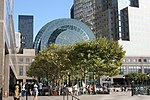Cortlandt Street Ferry Depot
1865 establishments in New York (state)Demolished buildings and structures in ManhattanFerries of New York CityFerry terminals in ManhattanNew York Central Railroad ... and 3 more
Pennsylvania RailroadTransit hubs serving New JerseyWater transportation in New York City

Cortlandt Street Ferry Depot was the main ferry terminal of the Pennsylvania Railroad and the West Shore Railroad on the North River (Hudson River) in lower Manhattan. The railroads operated ferries to their terminal stations on the Hudson River waterfront in New Jersey at Exchange Place and Weehawken, respectively. The depot was next to Liberty Street Ferry Terminal from which the Central Railroad of New Jersey operated its Communipaw ferry to Communipaw Terminal.
Excerpt from the Wikipedia article Cortlandt Street Ferry Depot (License: CC BY-SA 3.0, Authors, Images).Cortlandt Street Ferry Depot
West Street, New York Manhattan
Geographical coordinates (GPS) Address Nearby Places Show on map
Geographical coordinates (GPS)
| Latitude | Longitude |
|---|---|
| N 40.7115 ° | E -74.0149 ° |
Address
West Street 120
10281 New York, Manhattan
New York, United States
Open on Google Maps










